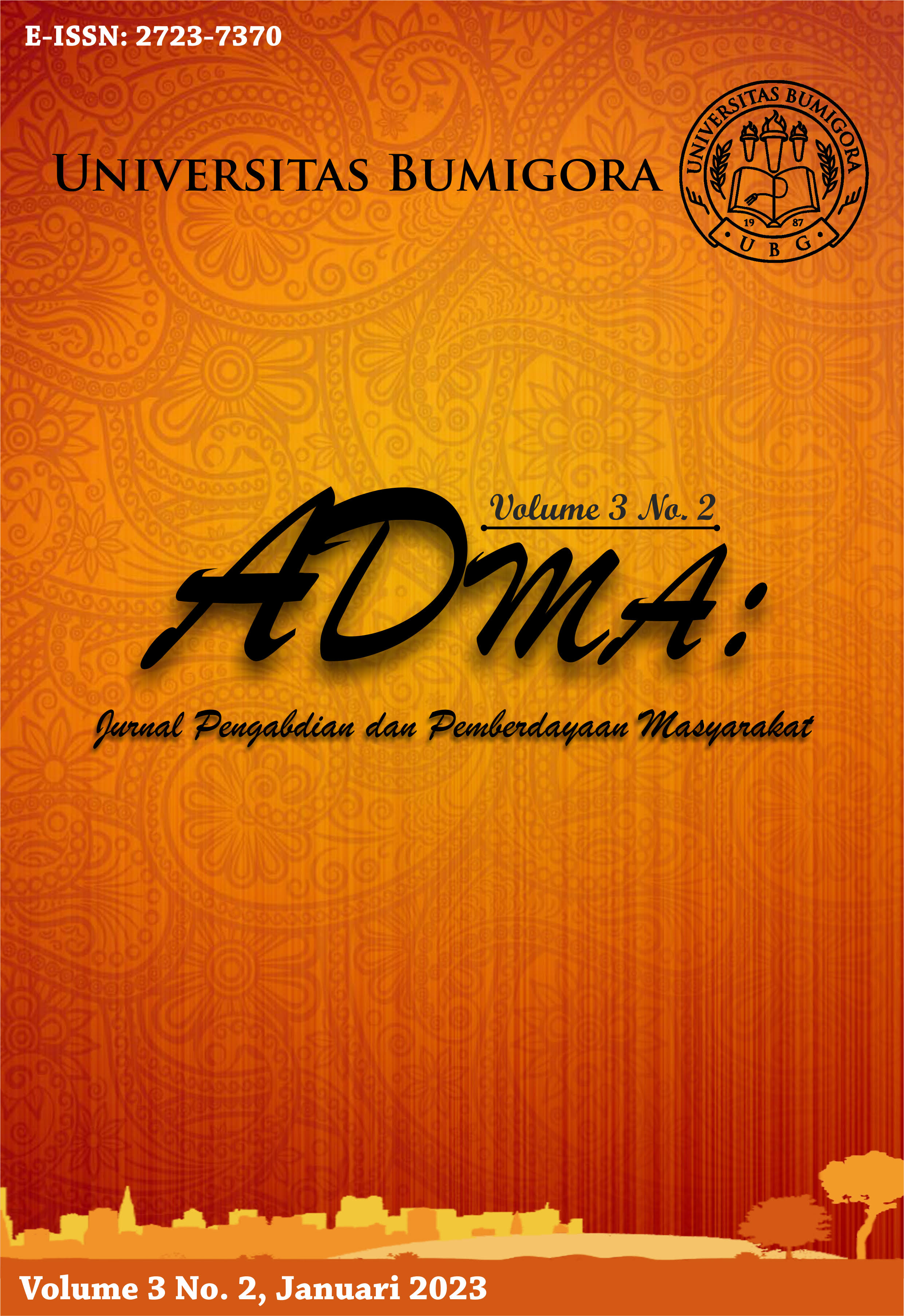Upaya Peningkatan Pengetahuan Ibu Nifas tentang Kandungan Daun Kelor (Moringa Oleifera) sebagai Pelancar Asi
Abstract
The Infant Mortality Rate (IMR) in Indonesia is still high. The infant mortality rate is largely due to nutritional factors. Exclusive breastfeeding can reduce infant morbidity and mortality. The most common reason found in breastfeeding mothers who stop breastfeeding is due to insufficient milk production. Utilization of plants/vegetables that function as galactogogue can be used as an alternative to increase milk production. Moringa leaves are one of the plants that people often use to increase milk production. Based on this, it is necessary to carry out health education about the content of Moringa leaves (Moringa Oleifera) as a breast milk booster. The purpose of health counseling is to increase the knowledge of postpartum mothers about the content of Moringa leaves as a breast milk booster. This health education activity was carried out on August 27 2022 in Jempong Baru Village, Sekarbela District, Mataram City. The method used in this devotional activity is using the lecture method, and for the media, namely the media using power point and leaflets. Posttest results obtained by postpartum mothers experienced an increase in knowledge after being given health education about the content of Moringa leaves as a breast milk booster. After the service activities, postpartum mothers are expected to be able to use Moringa leaves as an alternative in improving the smoothness of breastfeeding
References
Andriani DF, U. I. (2022). Pengaruh pendidikan kesehatan menggunakan media leaflet terhadap pengetahuan ibu tentang perawatan tali pusat bayi baru lahir. Human Care Journal., 7(2), 375–381.
Asnidawati, A., & Ramdhan, S. (2021). Hambatan Pemberian ASI Eksklusif Pada Bayi Usia 0-6 Bulan. Jurnal Ilmiah Kesehatan Sandi Husada, 10(1), 156–162. https://doi.org/10.35816/jiskh.v10i1.548.
Badan Perencanaan Pembangunan Nasional (BPPN). (2011). Laporan Pencapaian Tujuan Pembangunan Millenium di Indonesia.
Biks, G. A., Berhane, Y., Worku, A., & Gete, Y. K. (2015). Exclusive breast feeding is the strongest predictor of infant survival in Northwest Ethiopia: A longitudinal study. Journal of Health, Population and Nutrition, 34(1), 7–12. https://doi.org/10.1186/S41043-015-0007-Z.
Dikes Provinsi NTB. (2018). Profil Kesehatan Provinsi NTB Tahun 2018.
Handayani, S., Pratiwi, Y. S., & Fatmawati, N. (2021). Pemanfaatan Tanaman Lokal Sebagai Pelancar Asi (Galaktogogue). Jurnal Kebidanan Malahayati, 7(3), 518–522. https://doi.org/10.33024/jkm.v7i3.4451.
Horta BL, V. C. (2013). Short-term effects of breastfeeding: a systematic review on the benefts of breastfeeding on diarrhoea and pneumonia mortality. Geneva : World Health Organization. https://apps.who.int/iris/bitstream/handle/10665/95585/9789241506120_eng.pdf?sequence=1.
Ikatan Dokter Anak Indonesia. (2010). Indonesia menyusui.
Indrayani D, Gustirini R, H. S. (2015). Survei Pendahuluan tentang Pengalaman Menyusui dan Upaya untuk Meningkatkan Produksi ASI.
Kementerian Kesehatan RI. (2014). Profil Kesehatan Indonesia 2013.
Kementerian Kesehatan RI. (2017a). Profil Kesehatan Indonesia 2017. http://www.depkes.go.id/resources/download/pusdatin/profil-kesehatan-indonesia/Profil-Kesehatan-Indonesia-tahun-2017.pdf>[Diaksespada08Maret2019.
Kementerian Kesehatan RI. (2017b). Survei Demografi dan Kesehatan Indonesia (SDKI) 2017.
Khoirunnisa S, F. E. (2022). Pengaruh Pendidikan Kesehatan Masa Nifas Terhadap Pengetahuan Ibu Tentang Kemampuan Perawatan MandiriIbu Nifas. Jurnal Pendidikan Dan Konseling., 4(3), 1701–1706.
Lenja, A., Demissie, T., Yohannes, B., & Yohannis, M. (2016). Determinants of exclusive breastfeeding practice to infants aged less than six months in Offa district, Southern Ethiopia: A cross-sectional study. International Breastfeeding Journal, 11(1), 1–7. https://doi.org/10.1186/s13006-016-0091-8.
Margareth ZH. (2016). Asuhan Kehamilan, Persalinan, dan Nifas. Nuha Medika.
Mekuria, G., & Edris, M. (2015). Exclusive breastfeeding and associated factors among mothers in Debre Markos, Northwest Ethiopia: A cross-sectional study. International Breastfeeding Journal, 10(1), 1–7. https://doi.org/10.1186/s13006-014-0027-0
Notoatmodjo, S. (2007). Kesehatan masyarakat ilmu dan seni. Rineka Cipta.
Raguindin, P. F. N., Dans, L. F., & King, J. F. (2014). Moringa oleifera as a galactagogue. Breastfeeding Medicine, 9(6), 323–324. https://doi.org/10.1089/bfm.2014.0002.
Suryanti, Y. (2021). Pengaruh Penkes Menggunakan Metode Ceramah Dan Leaflet Terhadap Tingkat Kecemasan Primigravida. Jurnal Kesehatan Dan Pembangunan, 11(22), 110–118. https://doi.org/10.52047/jkp.v11i22.118.
World Health Organization. (2019). WHO global report on traditional and complementary medicine 2019. https://apps.who.int/iris/handle/10665/312342.
Wulandari ET, W. W. (2020). Gambaran Penggunaan Herbal Pelancar ASI (Galaktogogues) di Desa Wonosari Kabupaten Pringsewu. Wellness and Healthy Magazine, 2(2), 251–258. file:///C:/Users/user/Downloads/108-417-1-PB.pdf.
Zakaria, Hadju, V., As’ad, S., & Bahar, B. (2016). Pengaruh Pemberian Ekstrak Daun Kelor terhadap Kuantitas dan Kualitas Air Susu Ibu (ASI) Pada Ibu Menyusui Bayi 0-6 Bulan. Jurnal MKMI, 12(3), 161–169.

This work is licensed under a Creative Commons Attribution-ShareAlike 4.0 International License.











